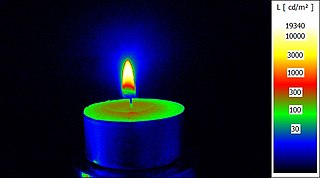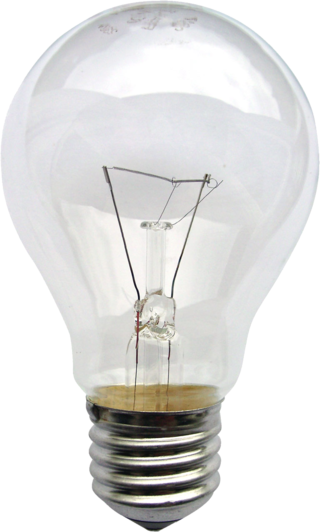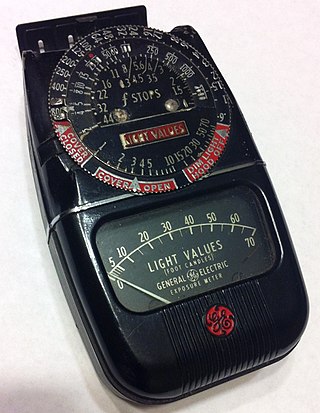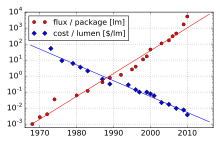
The candela is the unit of luminous intensity in the International System of Units (SI). It measures luminous power per unit solid angle emitted by a light source in a particular direction. Luminous intensity is analogous to radiant intensity, but instead of simply adding up the contributions of every wavelength of light in the source's spectrum, the contribution of each wavelength is weighted by the luminous efficiency function, the model of the sensitivity of the human eye to different wavelengths, standardized by the CIE and ISO. A common wax candle emits light with a luminous intensity of roughly one candela. If emission in some directions is blocked by an opaque barrier, the emission would still be approximately one candela in the directions that are not obscured.

A light-emitting diode (LED) is a semiconductor device that emits light when current flows through it. Electrons in the semiconductor recombine with electron holes, releasing energy in the form of photons. The color of the light is determined by the energy required for electrons to cross the band gap of the semiconductor. White light is obtained by using multiple semiconductors or a layer of light-emitting phosphor on the semiconductor device.

Luminance is a photometric measure of the luminous intensity per unit area of light travelling in a given direction. It describes the amount of light that passes through, is emitted from, or is reflected from a particular area, and falls within a given solid angle.

An incandescent light bulb, incandescent lamp or incandescent light globe is an electric light with a filament that is heated until it glows. The filament is enclosed in a glass bulb that is either evacuated or filled with inert gas to protect the filament from oxidation. Electric current is supplied to the filament by terminals or wires embedded in the glass. A bulb socket provides mechanical support and electrical connections.

The lux is the unit of illuminance, or luminous flux per unit area, in the International System of Units (SI). It is equal to one lumen per square metre. In photometry, this is used as a measure of the irradiance, as perceived by the spectrally unequally responding human eye, of light that hits or passes through a surface. It is analogous to the radiometric unit watt per square metre, but with the power at each wavelength weighted according to the luminosity function, a model of human visual brightness perception, standardized by the CIE and ISO. In English, "lux" is used as both the singular and plural form. The word is derived from the Latin word for "light", lux.

A luminous efficiency function or luminosity function represents the average spectral sensitivity of human visual perception of light. It is based on subjective judgements of which of a pair of different-colored lights is brighter, to describe relative sensitivity to light of different wavelengths. It is not an absolute reference to any particular individual, but is a standard observer representation of visual sensitivity of a theoretical human eye. It is valuable as a baseline for experimental purposes, and in colorimetry. Different luminous efficiency functions apply under different lighting conditions, varying from photopic in brightly lit conditions through mesopic to scotopic under low lighting conditions. When not specified, the luminous efficiency function generally refers to the photopic luminous efficiency function.

Photometry is a branch of optics that deals with measuring light in terms of its perceived brightness to the human eye. It is concerned with quantifying the amount of light that is emitted, transmitted, or received by an object or a system.
Wide-bandgap semiconductors are semiconductor materials which have a larger band gap than conventional semiconductors. Conventional semiconductors like silicon and selenium have a bandgap in the range of 0.7 – 1.5 electronvolt (eV), whereas wide-bandgap materials have bandgaps in the range above 2 eV. Generally, wide-bandgap semiconductors have electronic properties which fall in between those of conventional semiconductors and insulators.

A foot-candle is a non-SI unit of illuminance or light intensity. The foot-candle is defined as one lumen per square foot. This unit is commonly used in lighting layouts in parts of the world where United States customary units are used, mainly the United States. Nearly all of the world uses the corresponding SI derived unit lux, defined as one lumen per square meter.

In photometry, luminous flux or luminous power is the measure of the perceived power of light. It differs from radiant flux, the measure of the total power of electromagnetic radiation, in that luminous flux is adjusted to reflect the varying sensitivity of the human eye to different wavelengths of light.

In photometry, illuminance is the total luminous flux incident on a surface, per unit area. It is a measure of how much the incident light illuminates the surface, wavelength-weighted by the luminosity function to correlate with human brightness perception. Similarly, luminous emittance is the luminous flux per unit area emitted from a surface. Luminous emittance is also known as luminous exitance.

The lumen is the unit of luminous flux, a measure of the perceived power of visible light emitted by a source, in the International System of Units (SI). Luminous flux differs from power, which encompasses all electromagnetic waves emitted, including non-visible ones such as thermal radiation (infrared). By contrast, luminous flux is weighted according to a model of the human eye's sensitivity to various wavelengths; this weighting is standardized by the CIE and ISO.
Luminous efficacy is a measure of how well a light source produces visible light. It is the ratio of luminous flux to power, measured in lumens per watt in the International System of Units (SI). Depending on context, the power can be either the radiant flux of the source's output, or it can be the total power consumed by the source. Which sense of the term is intended must usually be inferred from the context, and is sometimes unclear. The former sense is sometimes called luminous efficacy of radiation, and the latter luminous efficacy of a light source or overall luminous efficacy.

The sulfur lamp is a highly efficient full-spectrum electrodeless lighting system whose light is generated by sulfur plasma that has been excited by microwave radiation. They are a particular type of plasma lamp, and one of the most modern. The technology was developed in the early 1990s and appeared promising, but was not a commercial success by the late 1990s. Since 2005, lamps are again being manufactured for commercial use.

Energy conversion efficiency (η) is the ratio between the useful output of an energy conversion machine and the input, in energy terms. The input, as well as the useful output may be chemical, electric power, mechanical work, light (radiation), or heat. The resulting value, η (eta), ranges between 0 and 1.

A grow light is an electric light that can help plants grow. Grow lights either attempt to provide a light spectrum similar to that of the sun, or to provide a spectrum that is more tailored to the needs of the plants being cultivated. Outdoor conditions are mimicked with varying colour temperatures and spectral outputs from the grow light, as well as varying the intensity of the lamps. Depending on the type of plant being cultivated, the stage of cultivation, and the photoperiod required by the plants, specific ranges of spectrum, luminous efficacy and color temperature are desirable for use with specific plants and time periods.

An LED lamp or LED light is an electric light that produces light using light-emitting diodes (LEDs). LED lamps are significantly more energy-efficient than equivalent incandescent lamps and fluorescent lamps. The most efficient commercially available LED lamps have efficiencies exceeding 200 lumens per watt (lm/W) and convert more than half the input power into light. Commercial LED lamps have a lifespan several times longer than both incandescent and fluorescent lamps.
Lumen maintenance is the most useful gauge to determine the lifetime or useful light output rating of an LED light source. Unlike traditional light sources such as incandescent lamps, LEDs rarely fail outright and instead continue to emit light, albeit at slowly diminishing rate over time. Lumen maintenance is the luminous flux remaining at any selected elapsed operating time. Lumen depreciation is the luminous flux lost over time, and thus the complement of lumen maintenance.
Light-emitting diodes (LEDs) produce light by the recombination of electrons and electron holes in a semiconductor, a process called "electroluminescence". The wavelength of the light produced depends on the energy band gap of the semiconductors used. Since these materials have a high index of refraction, design features of the devices such as special optical coatings and die shape are required to efficiently emit light. A LED is a long-lived light source, but certain mechanisms can cause slow loss of efficiency of the device or sudden failure. The wavelength of the light emitted is a function of the band gap of the semiconductor material used; materials such as gallium arsenide, and others, with various trace doping elements, are used to produce different colors of light. Another type of LED uses a quantum dot which can have its properties and wavelength adjusted by its size. Light-emitting diodes are widely used in indicator and display functions, and white LEDs are displacing other technologies for general illumination purposes.

The first Light-Emitting Diode (LED) was created in 1927 by Russian inventor Oleg Losev, and used silicon carbide as a semiconductor. However, electroluminescence as a phenomenon was discovered twenty years earlier by the English experimenter Henry Joseph Round of Marconi Labs, using the same crystal and a cat's-whisker detector. Despite having distributed his report in Soviet, German and British scientific journals, Losev's LED found no practical use for several decades, partly due to the very inefficient light-producing properties of the semiconductor used.














